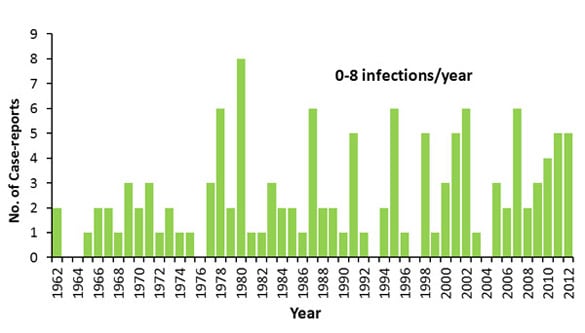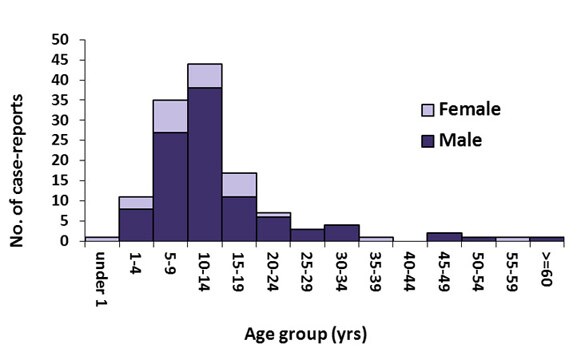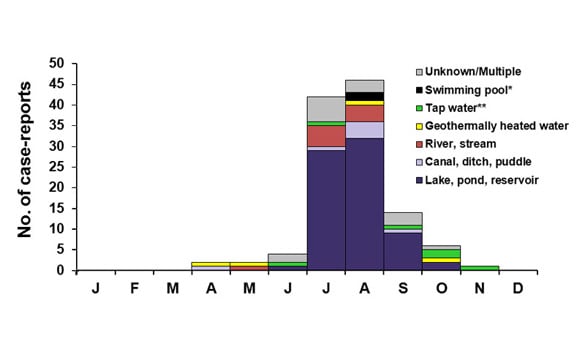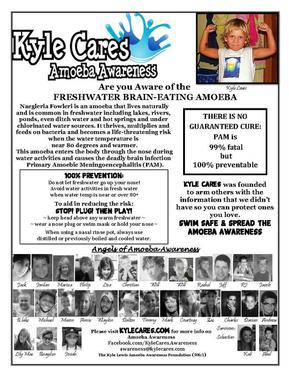My lame excuses aside, I ran across a clip this morning from a show called "Monsters Inside Me". I have seen this show before and liked what I had seen even though they make some things a little excessively dramatic. However, this clip was appropriately dramatic. This episode was about a family that lost their beautiful son and brother to an infection of Naegleria fowleri.
Some of you gasped when you read that scientific name (as you should) and others of you are sitting there with a confused look on your face. Naegleria fowleri is a species of amoeba that becomes opportunistically pathogenic when its natural freshwater habitats are exposed to prolonged periods of high temperatures. My first post was written about this parasite and can be read here for further information.
After watching the Monsters Inside Me clip, I Googled the name of the victim from the show. His name was Kyle Lewis. He was taken by the disease at only seven years old. His family lives in Arlington, Texas (which is pretty close to home for me) and has started an amoeba awareness organization called Kyle Cares. You can access the site from here.
After browsing the site for a bit and reading about other people who had been taken by these parasites, I began to notice that there were more confirmed cases than I had realized in the last few years. For those who may not know, this disease is extremely rare despite the ubiquitous nature of the non-infective forms of the amoebae in the southern United States. The disease caused by an infection of these amoebae is termed "Primary Amoebic Meningoencephalitis" or "PAM". I've always learned, as I stated above, that this is an extremely rare disease. However, this site claims that the disease is not as rare as many people think. Upon further reading, I learned that have been nearly 45 cases reported since the year 2000. Granted, this is pretty low, but it isn't nearly as low as I had imagined. Last summer alone there were at least three confirmed cases of PAM in the U.S. between the months of July and August. Below is a graph taken from the CDC's website showing how many cases of N. fowleri have been reported from 1962-2011.

This graph pretty much blew me away. I had no idea that we had THAT many confirmed cases. Upon further reading, I found this chart showing gender and age distribution of cases within the same dataset as the above graph.

The final graphic I wanted to include in this post shows a time distribution in addition to a means of infection for the same cases used in the dataset above.

As you can see, the parasites are most often pathogenic during the hottest months of the year and tend to be contracted from lakes, ponds, and reservoirs. It seems to occur more often in males than in females and is found most frequently in children and teenagers...though it is certainly not limited to these genders or ages.
 This disease has a rapid onset and is between 97% and 99% fatal depending on your source. The few who have survived this disease were given Amphotericin B...which has harsh side-effects from what I understand. The Kyle Cares website mentions that a group of researchers out of California have found a possible cure for PAM that works in vitro, but I have not yet been able to locate this particular paper. (If anyone has a copy, please e-mail me!) However, I was able to find a paper about a possible vaccine that a group of researchers in Korea have been working on. The vaccine has a 90% survival rate in experimentally infected mice. The big question here (other than the obvious, will it work for humans?) is whether or not a vaccine is practical. If it would save lives, it would be practical for people who live or vacation near freshwater bodies that exceed 80 degrees F during the summer months to get vaccinated. However, because the disease is relatively rare, does it really make sense to vaccinate everyone that we can? These are issues for people with far more public health experience than myself, but I do find it to be a fascinating new development for the worlds of parasites and immunology.
This disease has a rapid onset and is between 97% and 99% fatal depending on your source. The few who have survived this disease were given Amphotericin B...which has harsh side-effects from what I understand. The Kyle Cares website mentions that a group of researchers out of California have found a possible cure for PAM that works in vitro, but I have not yet been able to locate this particular paper. (If anyone has a copy, please e-mail me!) However, I was able to find a paper about a possible vaccine that a group of researchers in Korea have been working on. The vaccine has a 90% survival rate in experimentally infected mice. The big question here (other than the obvious, will it work for humans?) is whether or not a vaccine is practical. If it would save lives, it would be practical for people who live or vacation near freshwater bodies that exceed 80 degrees F during the summer months to get vaccinated. However, because the disease is relatively rare, does it really make sense to vaccinate everyone that we can? These are issues for people with far more public health experience than myself, but I do find it to be a fascinating new development for the worlds of parasites and immunology.Moral of the Story
I suppose the best thing to take away from this is to remember that our definitions of "rare" diseases may be a bit more fluid than what we realize. Though this disease is by no means common, we do seem to have spikes in cases during the hot, dry summer months such as those we are experiencing right now. The best idea is to avoid recreational water sports in lakes, ponds, etc. when the water is warmer than 80 degrees F. Also, if you haven't already done so, consider popping over to the Kyle Cares website and donate to their cause for continuing research and providing support for families affected by N. fowleri. Here's that site again, in case you missed it: Kyle Cares
If the confirmed cases blew you away, imagine how many unconfirmed or misdiagnosed cases are out there!
ReplyDeleteTHANK YOU!!! Thank you so much for spreading the awareness to even more and it's great to see our Kyle and awareness has made an effect on you. We'd love to chat more with you...email us awareness@kylecares.com
Swim Safe and Help Spread the
Kyle Cares Amoeba Awareness